The NVIDIA GeForce RTX 2080 Super Review: Memories of the Future
by Ryan Smith on July 23, 2019 9:00 AM EST- Posted in
- GPUs
- GeForce
- NVIDIA
- Turing
- GeForce RTX
Power, Temperatures, & Noise
Last, but not least of course, is our look at power, temperatures, and noise levels. While a high performing card is good in its own right, an excellent card can deliver great performance while also keeping power consumption and the resulting noise levels in check.
| GeForce Video Card Voltages | |||||
| RTX 2080S Boost | RTX 2080S Idle | RTX 2080 Boost | RTX 2070S Boost | ||
| 1.05v | 0.65v | 1.05v | 1.043v | ||
Overall, the voltages being used for the RTX 2080 Super are not any different than NVIDIA’s other TU104 cards – or any of their other Turing cards, for that matter. At its highest clockspeeds the card runs at 1.05v, quickly stepping down to below 1v at lower clockspeeds. The 0.65v idle voltage is among the lowest we’ve ever recorded for an NVIDIA card, however.
| GeForce Video Card Average Clockspeeds | |||||
| Game | RTX 2080S | RTX 2080 Ti | RTX 2080 | RTX 2070S | |
| Max Boost Clock | 1965MHz | 1950MHz | 1900MHz | 1950MHz | |
| Boost Clock | 1815MHz | 1545MHz | 1710MHz | 1770MHz | |
| Tomb Raider | 1937MHz | 1725MHz | 1785MHz | 1875MHz | |
| F1 2019 | 1920MHz | 1725MHz | 1785MHz | 1875MHz | |
| Assassin's Creed | 1920MHz | 1800MHz | 1815MHz | 1890MHz | |
| Metro Exodus | 1937MHz | 1755MHz | 1785MHz | 1875MHz | |
| Strange Brigade | 1920MHz | 1695MHz | 1770MHz | 1875MHz | |
| Total War: TK | 1937MHz | 1740MHz | 1785MHz | 1875MHz | |
| The Division 2 | 1937MHz | 1635MHz | 1740MHz | 1845MHz | |
| Grand Theft Auto V | 1937MHz | 1815MHz | 1815MHz | 1890MHz | |
| Forza Horizon 4 | 1937MHz | 1815MHz | 1800MHz | 1890MHz | |
Looking at clockspeeds, we can piece together a couple of interesting pieces of information. On the clockspeed side, NVIDIA hasn’t actually changed the card’s maximum clockspeed all that much. Our RTX topped out at 1900MHz, and the RTX 2080 Super is only a bit higher at 1965MHz. That they’re doing it without more voltage is a bit more interesting – it looks like chip quality may have improved a bit over the past year – but not too surprising.
What is more surprising however are the average clockspeeds we recorded for the RTX 2080 Super. In short, the card spends a lot of time at or near its top turbo bins. With temperature compensation active, our RTX 2080 Super tops out at 1937MHz; a clockspeed that it holds at for over half of our games even at 4K. Quite frankly the RTX 2080 Super is almost a boring card in this respect (in a good way); there’s just not much in the way of power throttling going on here. If anything, the hard part is getting the card above 90-95% power usage.
This, ultimately, is why the RTX 2080 Super is as fast as it is versus the vanilla RTX 2080. The extra SMs help, but it’s the extra 100-150MHz on the GPU clockspeed that’s really driving the card.
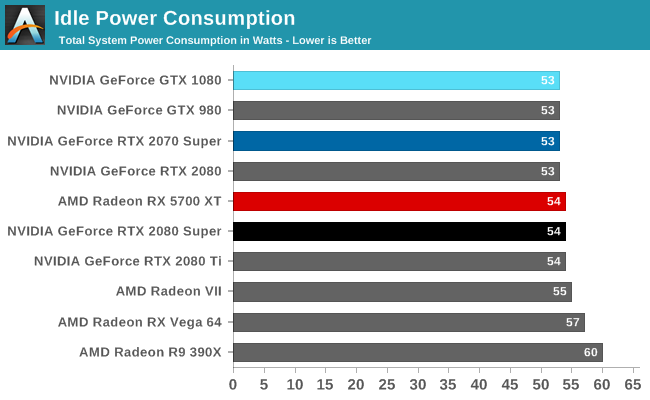
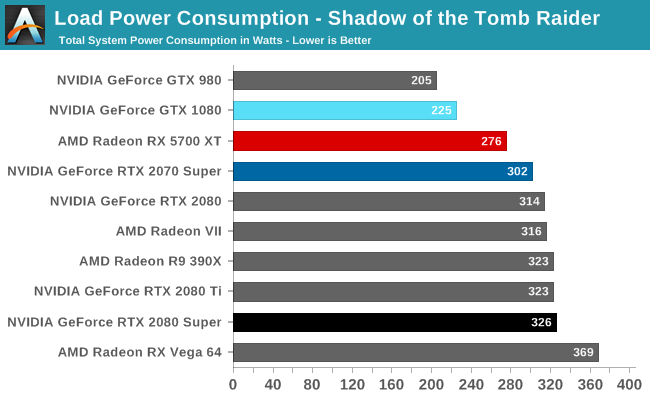
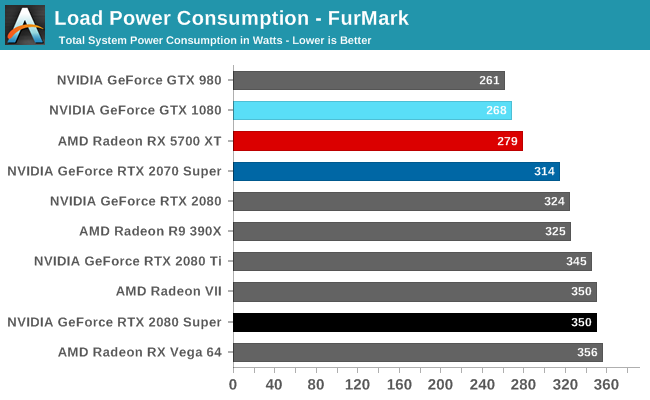
Getting to power consumption itself then, idle is effectively unchanged, exactly as we’d expect it. Load power, on the other hand, is paying the price for those 1900MHz+ clockspeeds. Under both FurMark and Tomb Raider, our RTX 2080 Super-equipped system is drawing almost the same amount of power as the RTX 2080 Ti system with a difference of just a few watts. That performance doesn’t come for free. NVIDIA’s overall power efficiency is still quite good here (the Radeon VII won’t be touching it, for example), but it’s clearly regressed a bit versus the RTX 2080 Ti and vanilla RTX 2080.
It is worth noting, however, that often the card was clockspeed-limited rather than power limited. So while Tomb Raider was specifically picked to be a punishing game – a task it delivered on here – I fully expect that the RTX 2080 Super is drawing a bit less than the RTX 2080 Ti in around half of our other games.
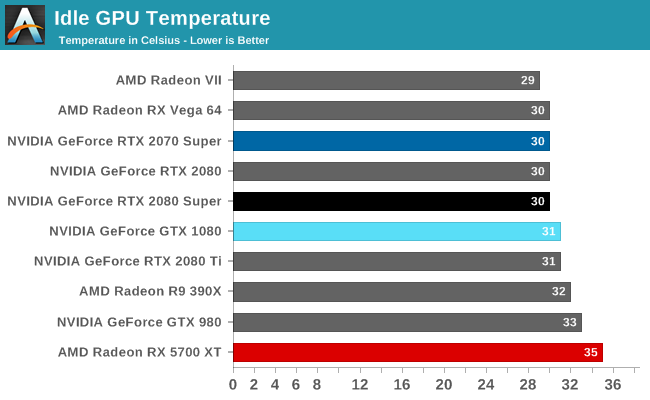
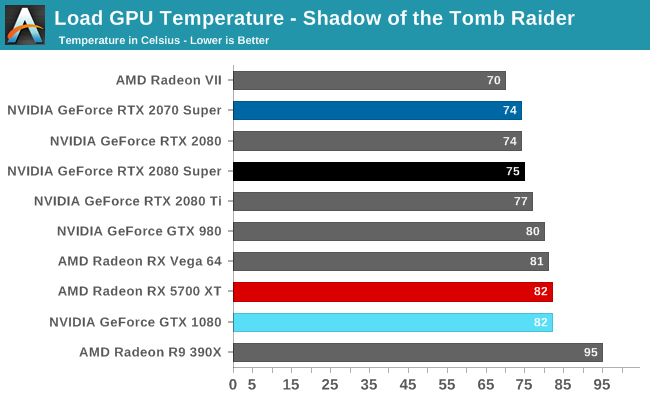

With higher power consumption and the same cooler comes higher temperatures. Even FurMark’s 77C is still several degrees below the card’s 84C thermal throttle point, but it is a very straightforward consequence of the increased power consumption.
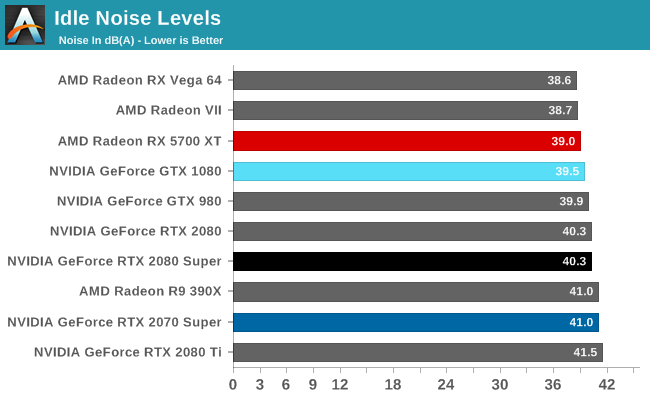
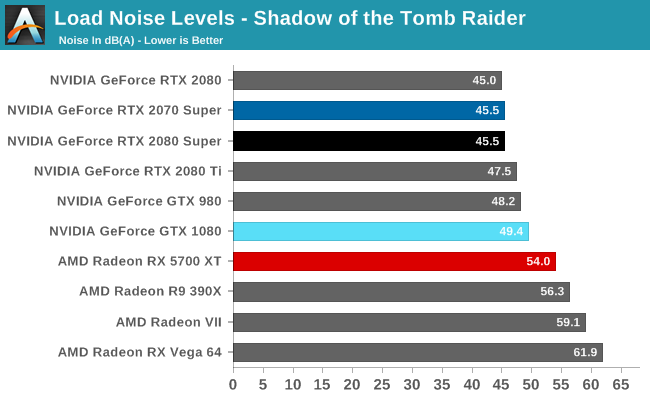
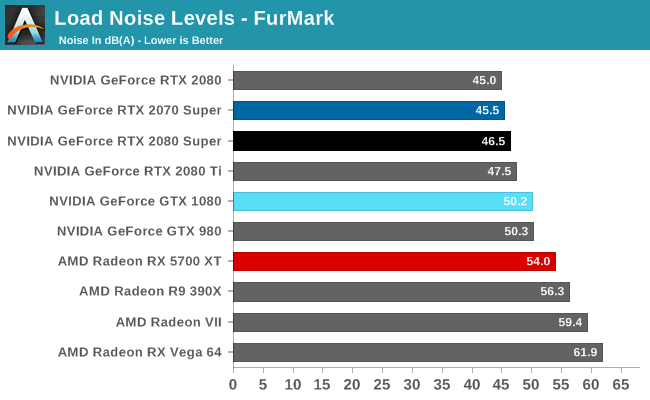
Last, but not least, we have noise. Again this is the same cooler as the RTX 2080 & RTX 2080 Ti, so the card has to work a bit harder to keep itself cool versus the original RTX 2080. The net result is that the RTX 2080 Super splits the difference between the original RTX 2080 and the RTX 2080 Ti, peaking at 46.5 dB(A). This is unlikely to be a very noticeable change as compared to the RTX 2080, but it’s louder none the less. I’m actually a bit surprised it didn’t pull even with the RTX 2080 Ti, but then our RTX 2080 Ti seems to run just a bit loud period – even at idle it’s a bit louder.










111 Comments
View All Comments
Korguz - Tuesday, July 23, 2019 - link
Maxiking, wow you hate amd.. but to be fair, nvidia is also guilty for the re brands as well, probably not as bad as amd.. but still bad :600 series
510 -> 605 (Fermi GF119)
GT520 -> GT610, GT620 (OEM), 705 (Fermi GF119)
GT530 -> GT620 (retail) (Fermi GF119)
GT440 (DDR3) -> GT630 (DDR3), GT730 (DDR3, 128-bit) (Fermi GF108)
GT440 (GDDR5) -> GT630 (GDDR5) (Fermi GF108)
GT545 (DDR3) -> GT640 (OEM) (Fermi GF116)
GTX560 SE (OEM) -> GT645 (Fermi GF114-400-A1)
700 series
GT630 (Kepler) -> GT740 (Kepler GK107)
GT630 (Kepler rev 2) -> GT710, GT720, GT730 (128-bit & GDDR5) (Kepler GK208)
210 -> 405 (OEM) (Tesla GT218)
GTX680 -> GTX770 (Kepler GK104)
but i am sure you will find some way to refute and ignore this fact.. but what ever man.
Spunjji - Friday, July 26, 2019 - link
If you're insisting that the RX590 is a rebrand, then congratulations, so are the Super cards - because Nvidia have done the exact same thing here (wait for yields and consistency to improve and use that to edge out a little more performance from the same silicon).You can spot the Nvidia shills because they show up yelling as though only AMD do rebrands, and as if a rebrand is somehow a form of robbery. Fact is it's been something both companies have done for decades now. Pretty sure G92 was the first product to go through three names (8800 GTS 512MB / 9800 GTX / GTS 240) and Nvidia's low-end products are even more prone to this.
ballsystemlord - Saturday, July 27, 2019 - link
FWIW: AMD's 500 series was clocked higher because the process had been improved, not because AMD wanted to make life worse for us by sandbagging on the 400 series. The 590 was just a cheap way to place something in between the 580 and Vega 56 and it was on a smaller node, so it's not *just* a rebrand. The RX 200 and 300 series were mostly rebrands, but if I'm an early adopter, how much trouble is it to check and find out that a card is just a rebrand and then not buy?jordanclock - Tuesday, July 23, 2019 - link
That is a lot of words to be wrong.These cards exist because yields got better since the architecture was launched last year. Not because of some sort of conspiracy by Nvidia to trick people into upgrading already. It's not bait-and-switch, mostly because you don't know the definition of bait-and-switch.
You don't need a card "without the ray trace crap being shoved in" because in games without RTX features, the RT cores don't do anything to harm performance in any way. The RTX 2080 performs essentially the same as a theoretical GTX 2080.
I won't address the rest of your tirade because it's clear you're just angry that Nvidia didn't come ask you personally what you wanted in a video card. While RTX hasn't been exactly a success, we should be encouraging Nvidia and AMD to find ways to improve game visuals besides higher resolution
GreenReaper - Wednesday, July 24, 2019 - link
They might need to have stocked up a sufficient number of chips of a certain quality in order to satisfy demand. It's little good announcing a card that renders another card redundant and not having enough chips to sell. You'll just get people buying neither of those cards.YB1064 - Tuesday, July 23, 2019 - link
Given the performance of AMD, it doesn't look like NVIDIA had to release anything. Their top card Radeon VII is supposed to be EOL. Looks like AMD are still far behind. Anything good on the horizon from AMD?Maxiking - Tuesday, July 23, 2019 - link
Yeah, that fabricated 4.7ghz boost on Ryzen 3950x.designgears - Tuesday, July 23, 2019 - link
They are behind at the highest end, but they're competitive in the mid-range which is where all the money is for them, so not a big deal when you look at it like that. They also power the current gen xb1/ps4 and next gen.Maxiking - Tuesday, July 23, 2019 - link
Obviously the money aren't there, the gpu division is constantly operating at a loss.Rudde - Thursday, July 25, 2019 - link
Radeon isn't operating at a loss. Apple reportedly paid a part of Vega development and they needed a gpu for their apus (i.e. all mobile parts). Vega is great at compute, earning AMD some extra revenue. Google placed a large order.Sony and Microsoft paid a part of Navi development and placed a huge order. Navi will be used in apus once again, bringing in some revenue.
Desktop gpus is not AMDs only gpu market, they need the same development for their other divisions.